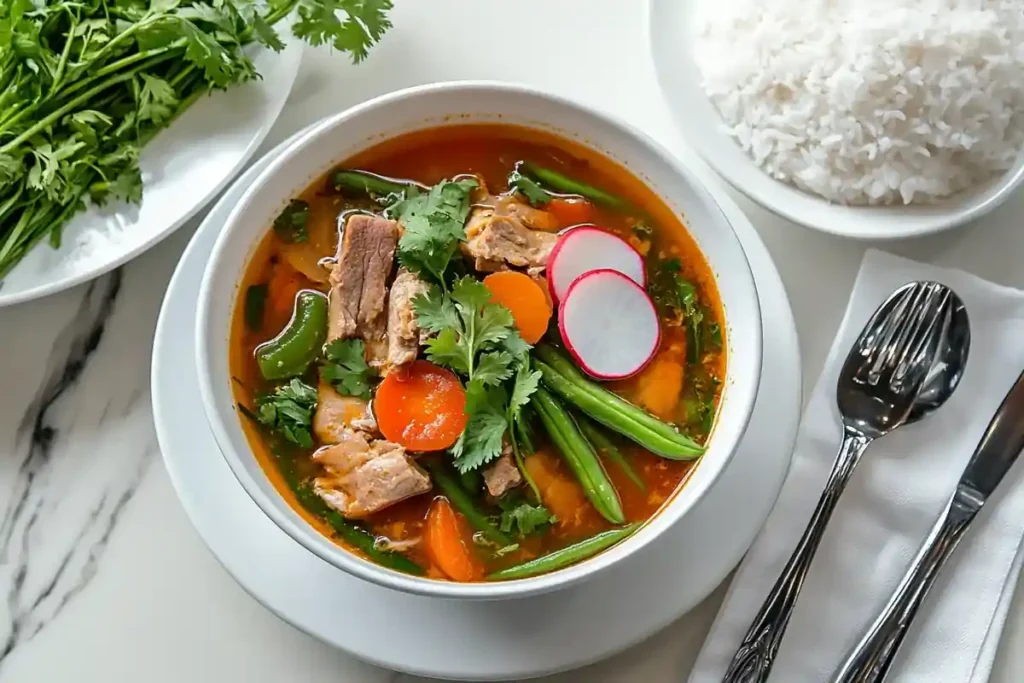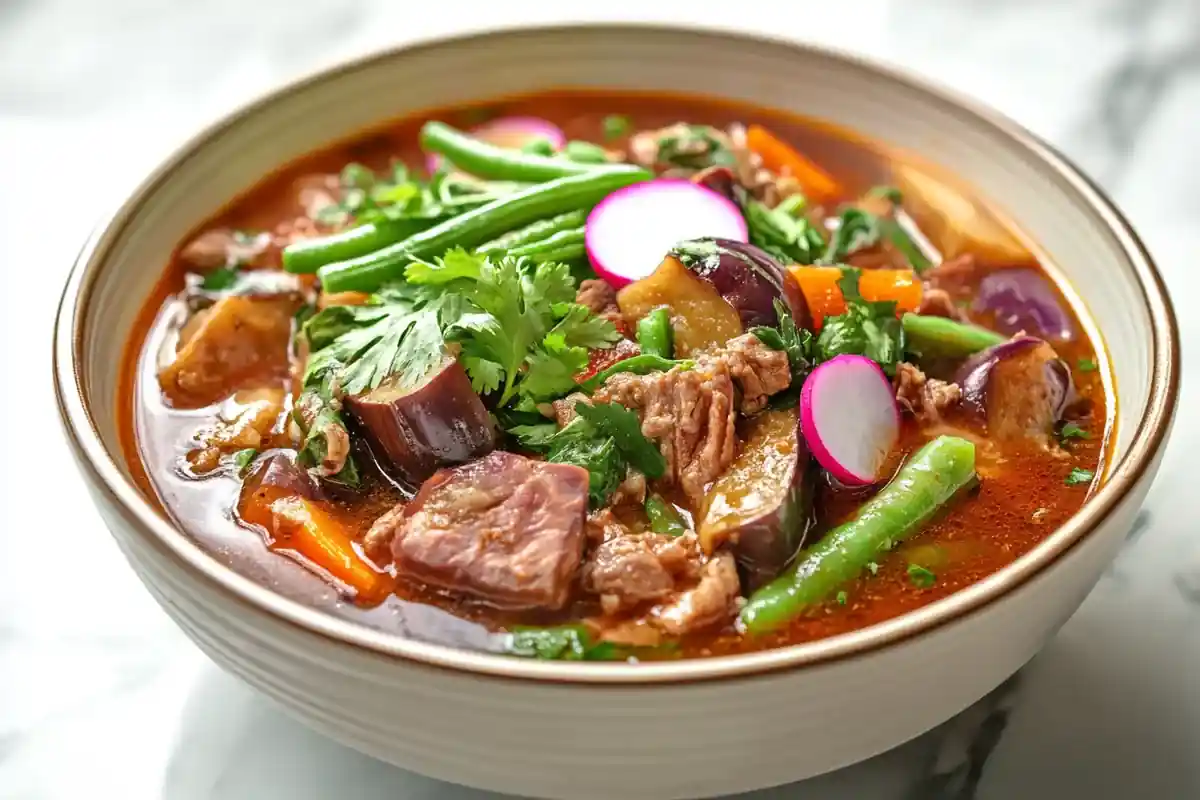Sinigang Recipe: A Flavorful Filipino Favorite
The sinigang recipe is a widely celebrated part of Filipino cooking, and it is especially loved for its tangy broth and healthy mix of vegetables and proteins. Not only does this favorite dish blend the sour taste of tamarind with a variety of ingredients, but it also makes for a comforting meal that’s perfect for any occasion. In this guide, we’ll cover everything you need to know to make the perfect sinigang, from choosing fresh ingredients to following the cooking steps.
What is Sinigang?
The Origin of Sinigang
Sinigang undoubtedly traces its roots back to the Philippines, where it has long been a beloved staple in Filipino households. Not only does this dish embody the rich culinary heritage of the country, but it also showcases a beautiful blend of local ingredients and traditional cooking methods. In fact, the name “sinigang” comes from the Filipino word meaning “stewed,” which perfectly captures its preparation style and essence.
Over time, sinigang has taken on many versions, changing based on local tastes and ingredients. Even with these changes, it remains a favorite for its comforting, home-cooked feel
The Unique Flavors of Sinigang
What makes sinigang different from other stews is its sour taste, usually from tamarind. This gives the soup a fresh, tasty flavor that pairs well with its hearty ingredients.
Other souring agents, like green mango, calamansi, or guava, can also be used, depending on local traditions. The mix of tasty meat, fresh vegetables, and sour broth creates a Charming balance that keeps people coming back for more.
Essential Ingredients for a Sinigang Recipe
Key Components of a Classic Sinigang
To make real sinigang, you need fresh vegetables, tasty meat or seafood, and something sour. Here’s a list of the main ingredients:
- Meat or Seafood: Pork belly (liempo), shrimp, or fish are popular protein options. Each type adds a unique flavor and texture to the dish.
- Souring Agent: Tamarind is the most commonly used, often available in paste or powder form. Alternatives include green mango, calamansi, or kamias.
- Vegetables: A medley of kangkong (water spinach), radish, eggplant, long beans, and tomatoes forms the backbone of the dish. These vegetables soak up the flavorful broth.
- Aromatics and Seasonings: Onion, garlic, fish sauce, and salt enhance the dish’s tasty profile, balancing the sourness.
Optional Ingredients to Elevate Flavor
While the classic version of sinigang is Charming, adding unique ingredients can personalize the recipe:
- Okra: Adds a slightly slimy texture that some people enjoy.
- Chilis: Bring a mild heat that pairs well with the sour broth.
- Miso: Often used in seafood sinigang, miso provides a creamy texture and rich umami flavor.

Step-by-Step Sinigang Recipe
Ingredients for Sinigang Recipe
For a Classic Pork Sinigang:
- 1 lb pork belly (liempo), cut into bite-sized pieces
- 8 cups water
- 1 packet tamarind soup mix (or 1 cup fresh tamarind paste)
- 2 medium-sized tomatoes, quartered
- 1 large onion, chopped
- 1 cup radish, sliced into thin rounds
- 1 cup eggplant, sliced into wedges
- 1 cup kangkong (water spinach) leaves
- 1 cup long beans, cut into 2-inch lengths
- 2 tablespoons fish sauce
- Salt and pepper to taste
Cooking Instructions for Sinigang Recipe
1: Prepare the Broth
- In a large pot, bring 8 cups of water to a boil.
- Add the pork belly and simmer for 20–30 minutes until tender, skimming off any scum that rises to the surface.
2: Build the Flavor
- Toss in the onion, tomatoes, and tamarind soup mix (or fresh tamarind paste). Let the broth simmer for another 10 minutes, allowing the flavors to meld.
3: Add the Vegetables
- Add the radish and eggplant to the pot. Simmer for 5 minutes, then follow with the long beans.
- Add the kangkong leaves last, as they cook quickly. Season the soup with fish sauce, salt, and pepper to taste.
4: Serve and Enjoy
- Turn off the heat and let the sinigang rest for a few minutes.
- Ladle the soup into bowls and serve hot with steamed rice.
Nutritional Information (Per 100g)
| Component | Amount |
|---|---|
| Calories | 62 kcal |
| Protein | 4.5 g |
| Fat | 3.8 g |
| Carbohydrates | 3.2 g |
| Sodium | 320 mg |
| Fiber | 1.2 g |
With these steps, you can recreate an real sinigang recipe that’s perfect for any occasion. In the next sections, we’ll explore variations and expert tips to take your sinigang to the next level!

Variations of the Sinigang Recipe
Exploring Different Proteins
Sinigang is a highly versatile dish that adapts beautifully to different types of proteins, each offering a unique twist on the classic recipe:
- Seafood Sinigang
- Replace pork with shrimp, fish (like milkfish or salmon), or squid.
- Add miso paste for a creamy, umami-packed broth.
- Beef Sinigang
- Use tender cuts like beef shank or brisket.
- The rich flavor of beef pairs wonderfully with the tangy tamarind base.
- Chicken Sinigang
- Opt for bone-in chicken pieces to enrich the broth with more flavor.
- This lighter variation is perfect for those seeking a leaner protein option.
Vegan and Vegetarian Options
For plant-based eaters, a vegan sinigang recipe is just as satisfying:
- Swap the meat with tofu or mushrooms for a hearty alternative.
- Increase the vegetable variety by adding sweet potatoes, zucchini, or baby corn.
- Use tamari or soy sauce in place of fish sauce for seasoning.
Using Alternative Souring Agents
While tamarind is the classic souring agent, experimenting with others can yield exciting flavors:
- Calamansi: A zesty citrus flavor for a lighter broth.
- Green Mango: Adds a fruity, tropical tang.
- Kamias (Bilimbi): Sharp and tart, commonly used in traditional Filipino households.
Pro Tips for Perfecting Your Sinigang Recipe
Achieving the Ideal Balance
One of the hallmarks of a great sinigang recipe is its balance of sourness, savoriness, and sweetness. Here’s how to fine-tune your dish:
- Gradually add the souring agent, tasting as you go to avoid over-souring.
- Adjust with a pinch of sugar if the tamarind flavor becomes too intense.
- Ensure the saltiness is just right by carefully measuring the fish sauce or salt.
Perfect Timing for Adding Vegetables
Timing is key when cooking vegetables in sinigang:
- Add hard vegetables like radish and carrots early to ensure they soften evenly.
- Toss in delicate greens, like kangkong, at the very end to preserve their vibrant color and texture.
Using Fresh Ingredients
Whenever possible, use fresh tamarind, vegetables, and herbs to elevate the flavor of your dish. Fresh ingredients add depth and richness to the broth, making the sinigang truly stand out.
For more delicious recipes, be sure to check out our Filipino Soup Collection on our website pampamrecipes.com, where you’ll find plenty of ideas to complement your sinigang creation!
The Cultural Significance of Sinigang
A Dish Rooted in Filipino Heritage
Sinigang undoubtedly holds a special place in Filipino culture, and it is often considered one of the Philippines’ national dishes. With its delightful mix of sour and tasty flavors, it not only showcases the country’s love for bold and comforting meals but also celebrates its culinary traditions. Furthermore, its flexible recipe easily adapts to local ingredients, highlighting Filipino creativity and resourcefulness.
From family dinners to celebrations, sinigang is a dish that brings people together. Its warm, hearty soup is a comfort food loved by all generations. Whether made with pork, seafood, or vegetables, it brings back memories of home-cooked meals shared with family.
Regional Variations Across the Philippines
Different regions in the Philippines have their spin on the traditional sinigang recipe:
- Luzon Style Sinigang
- Typically uses tamarind as the main souring agent.
- Common proteins include pork and milkfish (bangus).
- Visayas Sinigang
- Features seafood such as shrimp or crab.
- Often includes tomatoes and leafy greens for a vibrant presentation.
- Mindanao Sinigang
- Incorporates indigenous sour fruits like batuan or green mangoes.
- Adds chili for a subtle heat that balances the sourness.
Each variation highlights the Philippines’ rich culinary diversity, making sinigang a versatile and deeply personal dish.
FAQs About the Sinigang Recipe
What Makes Sinigang Unique Compared to Other Soups?
Sinigang stands out among soups worldwide for its distinctive sour and tasty flavor profile. Unlike creamy or purely tasty soups, sinigang incorporates a tanginess that awakens the palate and balances the richness of the protein. This sourness, derived from tamarind, calamansi, or other souring agents, is not just unique—it’s iconic to Filipino cuisine.
Flavor Complexity
Sinigang effortlessly combines layers of flavors: the tang of tamarind, the sweetness of tomatoes, and the umami of proteins like pork, shrimp, or fish. Additionally, this interplay creates a comforting yet vibrant dish that’s not only versatile but also perfect for any occasion. Whether it’s a casual lunch or a festive dinner, sinigang never fails to delight.
Cultural Significance
Sinigang is more than a soup; it’s a cultural staple in the Philippines. It’s a dish that brings families together, often served during gatherings and celebrations. The traditional preparation and its ability to evoke a sense of home make it a beloved meal across generations.
Healthy and Customizable
Its mix of fresh vegetables, lean protein, and flavorful broth makes sinigang not only delicious but also nutritious. It’s a dish you can easily adapt by swapping proteins or adding seasonal produce.
Can I Make Sinigang Ahead of Time?
Yes, indeed, you can make sinigang ahead of time, and it actually improves with age! As a matter of fact, the flavors deepen and meld together beautifully as the ingredients sit in the broth. By the next day, the dish boasts a more robust and satisfying taste, making it a fantastic option for meal prepping or leftovers.
Storage Tips
- Refrigeration: Store the cooked sinigang in an airtight container in the fridge. It will keep well for up to 3 days.
- Separate Greens: If using leafy greens like kangkong or spinach, store them separately and add them when reheating to avoid overcooking.
Reheating Tips
- Reheat the sinigang on the stovetop over medium heat until the broth is hot but not boiling.
- Taste the broth and adjust the seasoning or sourness as needed after reheating.
What’s the Best Way to Adjust the Sourness in Sinigang?
The sourness of sinigang is its defining characteristic, but personal preferences for tanginess vary. Luckily, it’s easy to tweak the sourness to your liking.
Increasing Sourness
- Add a small amount of tamarind paste or powder directly to the simmering broth.
- For a more natural approach, mash fresh tamarind or calamansi juice into the broth.
Reducing Sourness
- Dilute the broth with a bit of water or add additional stock to mellow the tang.
- Stir in a teaspoon of sugar to balance the acidity without overpowering the other flavors.
Pro Tip
To ensure the perfect balance of flavors, always add souring agents gradually and taste the soup after each addition. Additionally, this step-by-step approach helps you achieve the desired level of tanginess without going overboard. In the same way, you can adjust other seasonings to complement the sourness.
Can I Freeze Sinigang for Later?
Absolutely, sinigang freezes well, making it an excellent meal prep option for busy days. In fact, proper storage techniques, such as using airtight containers or freezer bags, ensure that its flavor and texture are preserved for weeks. Moreover, reheating is simple, allowing you to enjoy a hearty meal with minimal effort.
Freezing Instructions
- Cool Completely: Allow the sinigang to cool to room temperature before transferring it to freezer-safe containers.
- Portion It Out: Divide into smaller portions for easier reheating.
- Label and Date: Label the container with the date to track freshness.
Storage Duration
Sinigang can be stored in the freezer for up to 3 months. After that, the quality of the broth and vegetables may begin to degrade.
Reheating from Frozen
- Thaw the sinigang in the refrigerator overnight.
- Reheat on the stovetop over medium heat, stirring occasionally.
- Taste and adjust the seasonings, as freezing can sometimes dull the flavors slightly.
By following these tips, you can enjoy sinigang anytime without compromising its delicious taste and comforting warmth.
For inspiration, explore this guide to Dilicious recipes
How Do You Jazz Up Vegetables? Creative Tips and Recipes

Tips and Tricks for Perfecting Your Sinigang Recipe
Mastering the Broth
The broth is truly the heart of any sinigang recipe, so achieving the right balance of sourness and savoriness is absolutely key. To help you perfect it, here are a few expert tips that will surely elevate your sinigang broth to the next level:
- Start with Fresh Ingredients: Use fresh tamarind, tomatoes, and vegetables to ensure robust flavors.
- Layer the Flavors: Sauté the aromatics like onions, garlic, and tomatoes before adding water to deepen the broth’s taste.
- Customize the Souring Agent: Experiment with tamarind paste, calamansi, or green mangoes to find your preferred level of tanginess.
- Simmer Slowly: Allow the meat or seafood to cook gently in the broth, infusing it with rich, tasty flavors.
Enhancing Texture and Presentation
For a visually appealing and satisfying dish:
- Cut Ingredients Uniformly: Chop vegetables into even sizes to ensure consistent cooking.
- Add Greens at the End: Stir in spinach, kangkong (water spinach), or bok choy just before serving to preserve their bright color and crisp texture.
- Top with Fresh Herbs: Garnish with cilantro or green onions for an extra layer of aroma and freshness.
Health Benefits of the Sinigang Recipe
Packed with Nutrients
Sinigang is not just flavorful; it’s also a nutritious meal. The vegetables, proteins, and tamarind contribute a wide range of health benefits:
- Rich in Vitamins: Leafy greens provide vitamin K, while tamarind and tomatoes offer vitamin C for a boosted immune system.
- Low in Calories: A serving of sinigang is light yet filling, making it an excellent choice for weight management.
- Good Source of Protein: Depending on the protein used (pork, fish, or shrimp), sinigang can support muscle repair and growth.
Nutritional Content (per 100g)
| Component | Amount |
|---|---|
| Calories | 50 kcal |
| Protein | 4 g |
| Carbohydrates | 6 g |
| Fat | 1.5 g |
| Sodium | 200 mg |
A Perfect Fit for Healthy Diets
Sinigang is a fantastic addition to any balanced diet because it seamlessly combines low-fat proteins and nutrient-dense vegetables. Moreover, its versatility allows you to adapt it to various dietary preferences without losing its delicious taste. In addition, this dish provides a satisfying way to eat healthily while enjoying bold flavors. As a result, sinigang is an ideal choice for individuals aiming to maintain a nutritious lifestyle without compromising on flavor. You can easily tailor the sinigang recipe to meet dietary needs, such as using leaner cuts of meat or increasing the vegetable portions for a plant-forward meal.
Whether you’re seeking comfort food or a healthy, flavorful dish, sinigang offers the best of both worlds. Experiment, savor, and enjoy the timeless appeal of this Filipino classic!
FOR MORE DELICIOUS RECIPES:
VISIT OUR WEBSITE Pampamrecipes.com

